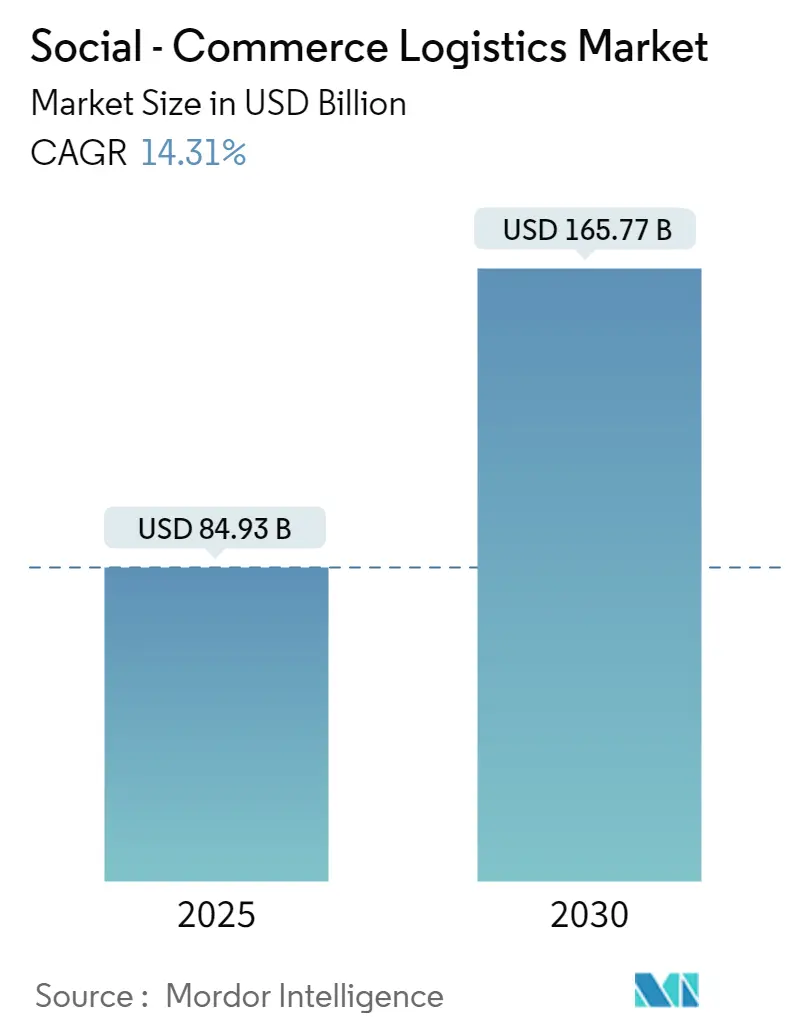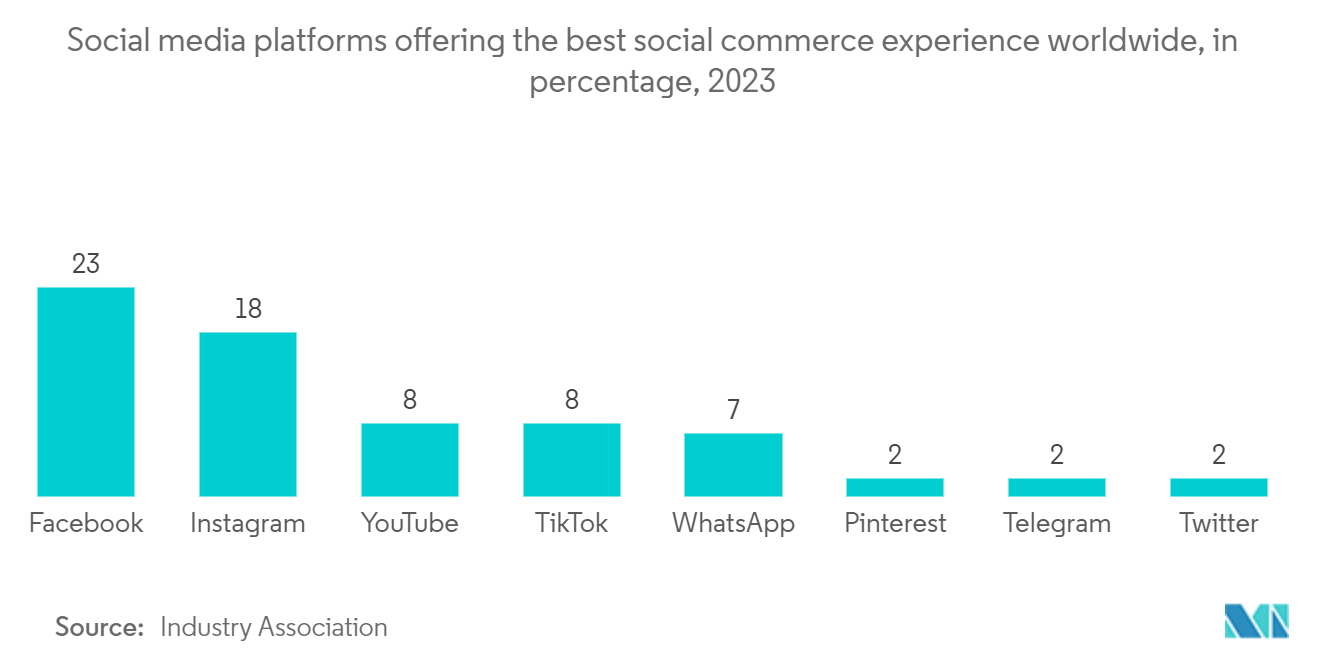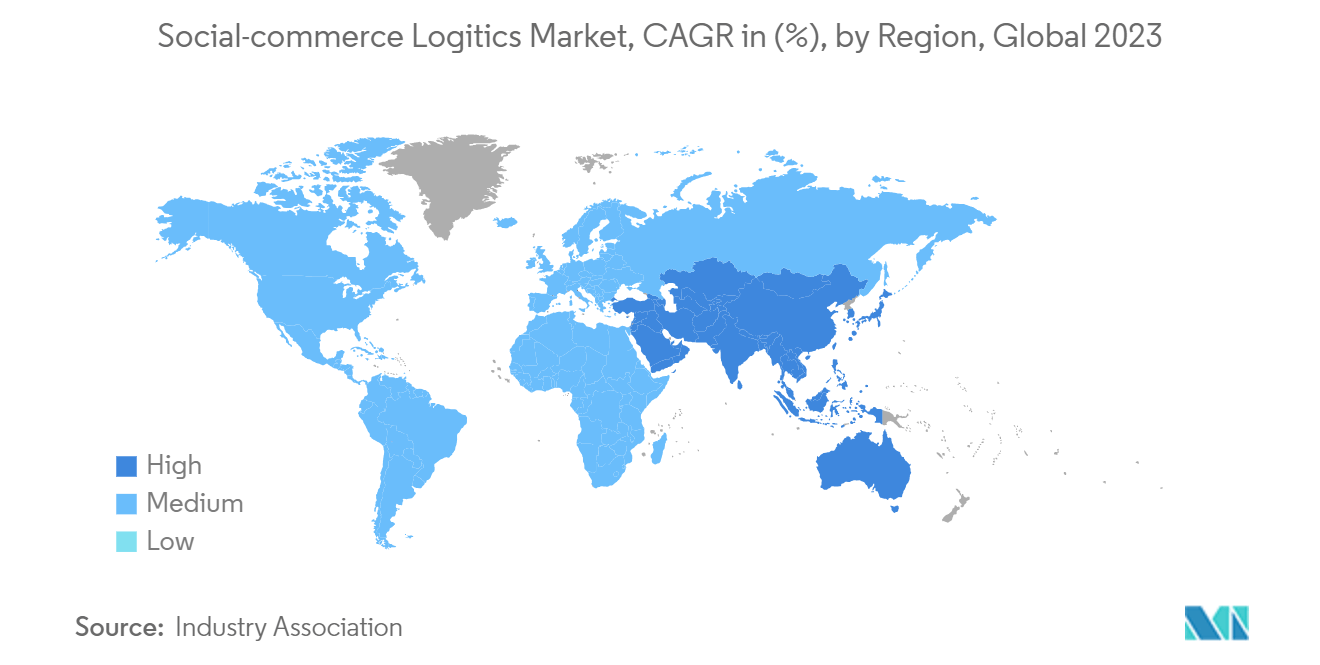Social - Commerce Logistics Market Size and Share

Social - Commerce Logistics Market Analysis by Mordor Intelligence
The Social - Commerce Logistics Market size is estimated at USD 84.93 billion in 2025, and is expected to reach USD 165.77 billion by 2030, at a CAGR of 14.31% during the forecast period (2025-2030).
- Social commerce, the fusion of e-commerce and social media, has revolutionized how retailers worldwide interact with consumers. With the surge in demand for convenient online shopping, companies are capitalizing on these platforms. Social media allows shoppers to seamlessly browse and buy products without leaving the platform, streamlining the purchasing process.
- The popularity of social media as an e-commerce tool is surging. By 2024, the penetration rate of social shopping is set to hit nearly 25.5%, with further growth projected. Notably, Asian markets, especially Thailand and China, show high enthusiasm, with around 90% of online consumers actively engaging in social buying.
- Social media is a significant source of inspiration and discovery for consumers before shopping. A 2023 survey revealed that 60% of social media users utilized these platforms to explore new products and brands. In 2023, Facebook emerged as the favored social commerce platform for over a quarter of global shoppers, closely followed by Instagram, which garnered 20% of respondents' preferences. Both Facebook and Instagram, owned by Meta, are the top social networks that provide the most compelling social commerce experiences. Across the globe, the most popular product categories purchased via social networks include apparel, personal care items, groceries, and food.
- Social commerce has gained traction across all age groups, with younger consumers leading the charge. Gen Z, having grown up in the digital age, and millennials, enjoying financial independence, are particularly keen on social media shopping. While these groups differ in motivations, they share a common desire to engage in shopping experiences over mere transactions. This shared inclination makes them highly receptive to products endorsed by influencers and celebrities. A 2023 study highlighted that promotions and simplified purchase processes are pivotal in boosting social commerce engagement.
Global Social - Commerce Logistics Market Trends and Insights
Rising B2C Social commerce Demand Steers Market Growth
Driven by its expansive customer base, opportunities for consumer engagement, and the ability to foster direct client relationships, the B2C segment stands as the cornerstone of the social commerce logistics market. With factors such as social media recommendations, robust purchasing patterns, and a seamless mobile interface, B2C social commerce is expanding.
Recently, there has been a surge in the utilization of social networking platforms for direct e-commerce transactions. These platforms have evolved into indispensable tools for businesses, enabling them not only to enhance brand visibility but also to generate revenue directly. As consumers increasingly flock to social media, businesses are capitalizing on the vast audience reach. Platforms like Facebook, Instagram, Pinterest, and TikTok boast user bases in the millions, if not billions, making them prime B2C arenas.
Today's consumers, especially millennials and Gen Z, crave instant gratification. With the rapid evolution of mobile technology, they are actively seeking novel ways to engage with brands digitally. Notably, over 60% of purchases are transacted through social media platforms, underscoring the dominance of younger demographics in social commerce.

Asia-Pacific Dominates the Market, Fueled by Population, Digital Payments, and Social Media Influence
Social media usage is pervasive in Southeast Asia, with penetration rates ranging from 68.9% to 91.7% in the region's key countries. Beyond its vast consumer base, Southeast Asia also boasts high social media engagement. The crux of social commerce's success here hinges on how consumers leverage social platforms. In Southeast Asia, social media reigns as the primary avenue for new product discovery, brand consideration, and product research. Moreover, the convenience it offers stands out as the top reason driving consumers to embrace social commerce.
The pandemic catalyzed a significant shift in Southeast Asian shopping habits, with a notable surge in online shopping. While app and website purchases saw a substantial uptick, a noteworthy segment of users ventured into social commerce for the first time. Notably, the adoption rates and market sizes of social commerce vary across Southeast Asia. For instance, Vietnam's social commerce logistics market, though smaller than Indonesia's, the region's e-commerce giant, is gaining ground. Vietnam not only leads in social commerce interest but also boasts the highest share of first-time users in the region.
Within Asia-Pacific, TikTok Shop emerged as a pivotal player in the social commerce arena. Its unique approach, where users stumble upon products through viral content, influencer endorsements, and live streams, has not only revolutionized online shopping but also made a significant impact on the region's digital economy.
In nations like Indonesia, Thailand, and Malaysia, TikTok Shop has capitalized on the surging mobile penetration rates and the increasing appetite for online shopping. This has empowered small and medium-sized enterprises with unprecedented market access. The platform's standout feature is its integration of creators and multi-channel networks (MCNs), pioneering what it terms "shoppertainment." Unlike its competitors, ByteDance, TikTok's parent company, swiftly leveraged this fusion of shopping and entertainment, setting a new benchmark for e-commerce on social platforms.

Competitive Landscape
The social commerce logistics market is fragmented in nature. Several key players dominate the market studied, including Shiprocket, Delhivery, Ekart, XpressBees, Shadowfax, Ecom Express, Blue Dart, Wow Express, Gati, and Rivigo. These firms specialize in logistics solutions designed specifically for social commerce enterprises. Their emphasis lies in delivering efficient and dependable services, aligning with the rising trend of social media sales. Key competitive factors in the market include delivery speed, cost efficiency, tech integration, and top-tier customer service, all tailored to the distinct needs of the social commerce realm.
Social - Commerce Logistics Industry Leaders
-
Shiprocket
-
Delhivery
-
Ekart
-
Xpressbees
-
Shadowfax
- *Disclaimer: Major Players sorted in no particular order

Recent Industry Developments
- June 2024: Third-party logistics companies such as Delhivery and XpressBees, traditionally catering to e-commerce, are pivoting toward the quick-commerce industry. This shift comes in response to the rising demand on platforms like Swiggy Instamart, Blinkit, and Zepto.
- March 2024: Shiprocket, a platform that consolidates logistics services for small online sellers, expanded its service portfolio in conjunction with a recent funding round. These new services, initially tested, encompass fintech solutions such as checkout services, working capital loans, insurance, and an enhanced focus on international shipping.
Global Social - Commerce Logistics Market Report Scope
Social commerce integrates social media and online platforms to facilitate social interactions. E-commerce, on the other hand, is the broader concept of buying and selling goods or services online. In this context, logistics services are pivotal in streamlining product storage, transportation, and delivery from social commerce channels. The emphasis is on fine-tuning the supply chain to guarantee prompt and economical deliveries for customers transacting on social media platforms.
The social commerce logistics market is segmented by business model (business-to-consumer (B2C), business-to-business (B2B), and consumer-to-consumer (C2C)), service (transportation, warehousing and inventory management, and value-added services [labeling and packaging]), product type (personal and beauty care, apparel, accessories, home products, health supplements, food and beverages, and other product types), sales channel (video commerce, social network-led commerce, social reselling, group buying, and product review platforms), and geography (North America, Europe, Asia-Pacific, South America, and Middle East and Africa). The report offers market sizes and forecasts in value (USD) for all the above segments.
| Business-to-consumer (B2C) |
| Business-to-business (B2B) |
| Consumer-to-consumer (C2C) |
| Transportation |
| Warehousing and Inventory Management |
| Value-added Services (Labeling and Packaging) |
| Personal and Beauty Care |
| Apparel |
| Accessories |
| Home Products |
| Health Supplements |
| Food and Beverages |
| Other Product Types |
| Video Commerce |
| Social Network-Led Commerce |
| Social Reselling |
| Group Buying |
| Product Review Platforms |
| North America | United States |
| Canada | |
| Mexico | |
| Rest of North America | |
| Europe | United Kingdom |
| Germany | |
| France | |
| Russia | |
| Italy | |
| Spain | |
| Rest of Europe | |
| Asia-Pacific | India |
| China | |
| Japan | |
| Australia | |
| Rest of Asia-Pacific | |
| South America | Brazil |
| Argentina | |
| Rest of South America | |
| Middle East and Africa | United Arab Emirates |
| South Africa | |
| Rest of Middle East and Africa |
| By Business Model | Business-to-consumer (B2C) | |
| Business-to-business (B2B) | ||
| Consumer-to-consumer (C2C) | ||
| By Service | Transportation | |
| Warehousing and Inventory Management | ||
| Value-added Services (Labeling and Packaging) | ||
| By Product Type | Personal and Beauty Care | |
| Apparel | ||
| Accessories | ||
| Home Products | ||
| Health Supplements | ||
| Food and Beverages | ||
| Other Product Types | ||
| By Sales Channel | Video Commerce | |
| Social Network-Led Commerce | ||
| Social Reselling | ||
| Group Buying | ||
| Product Review Platforms | ||
| By Geography | North America | United States |
| Canada | ||
| Mexico | ||
| Rest of North America | ||
| Europe | United Kingdom | |
| Germany | ||
| France | ||
| Russia | ||
| Italy | ||
| Spain | ||
| Rest of Europe | ||
| Asia-Pacific | India | |
| China | ||
| Japan | ||
| Australia | ||
| Rest of Asia-Pacific | ||
| South America | Brazil | |
| Argentina | ||
| Rest of South America | ||
| Middle East and Africa | United Arab Emirates | |
| South Africa | ||
| Rest of Middle East and Africa | ||
Key Questions Answered in the Report
How big is the Social - Commerce Logistics Market?
The Social - Commerce Logistics Market size is expected to reach USD 84.93 billion in 2025 and grow at a CAGR of 14.31% to reach USD 165.77 billion by 2030.
What is the current Social - Commerce Logistics Market size?
In 2025, the Social - Commerce Logistics Market size is expected to reach USD 84.93 billion.
Who are the key players in Social - Commerce Logistics Market?
Shiprocket, Delhivery, Ekart, Xpressbees and Shadowfax are the major companies operating in the Social - Commerce Logistics Market.
Which is the fastest growing region in Social - Commerce Logistics Market?
Asia Pacific is estimated to grow at the highest CAGR over the forecast period (2025-2030).
Which region has the biggest share in Social - Commerce Logistics Market?
In 2025, the Asia Pacific accounts for the largest market share in Social - Commerce Logistics Market.
What years does this Social - Commerce Logistics Market cover, and what was the market size in 2024?
In 2024, the Social - Commerce Logistics Market size was estimated at USD 72.78 billion. The report covers the Social - Commerce Logistics Market historical market size for years: 2020, 2021, 2022, 2023 and 2024. The report also forecasts the Social - Commerce Logistics Market size for years: 2025, 2026, 2027, 2028, 2029 and 2030.
Page last updated on:
Social - Commerce Logistics Market Report
Statistics for the 2025 Social - Commerce Logistics market share, size and revenue growth rate, created by Mordor Intelligence™ Industry Reports. Social - Commerce Logistics analysis includes a market forecast outlook for 2025 to 2030 and historical overview. Get a sample of this industry analysis as a free report PDF download.



